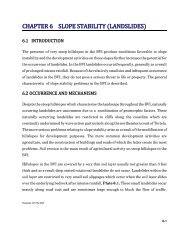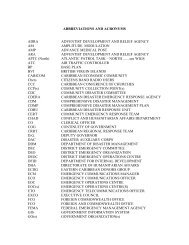Developers
Homeowners Handbook - The Department of Disaster Management
Homeowners Handbook - The Department of Disaster Management
- No tags were found...
You also want an ePaper? Increase the reach of your titles
YUMPU automatically turns print PDFs into web optimized ePapers that Google loves.
Fire ExtinguishersTo guard against small fires or to keep a small fire fromdeveloping into a big one, every home should be equippedwith fire extinguisher. Because almost all fires are small atfirst, they might be contained if a fire extinguisher is handyand used properly. You should take care, however, to selectthe right kind of fire extinguisher, because there are differentones for different kinds of fires. Install fire extinguishers onevery level of the home and include the kitchen, basementand garage.Selecting a Fire ExtinguisherExtinguishers are classified according to the class of fire forwhich they are suitable. The four classes of fires are A, B, C,and D:Class A fires involve common combustibles such as wood,paper, cloth, rubber, trash and plastics. They are common intypical commercial and home settings.Class B fires involve flammable liquids, solvents, oil, gasoline,paints, lacquers and other oil-based products. Class B firesoften spread rapidly. Unless they are properly suppressed,they can re-flash after the flames have been extinguished.Class C fires involve energized equipment such as wiring,controls, motors, machinery or appliances. They can becaused by a spark, a power surge, or a short circuit andtypically occur in locations that may be difficult to see orreach.Class D fires involve combustible metals.A typical home of office fire extinguisher should have an ABCrating.103










